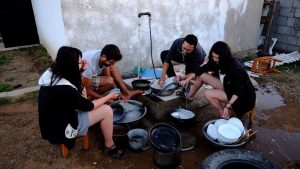🌏 Humanitarian Mission in Mongolia: Complete Guide
2025 Update – Reading time: about 15 – 20 minutes
✨ Introduction: Why a Humanitarian Mission in Mongolia?
Sprawling across Central Asia, Mongolia stretches from endless steppes to snow-capped mountains and the Gobi Desert. Bordered by Russia and China, it combines age-old nomadic traditions with rapid modernization. Yet behind these majestic landscapes lie social challenges: overcrowding and pollution in Ulaanbaatar’s ger districts, limited access to education and healthcare in rural areas, and a harsh, unforgiving winter climate.
Joining a humanitarian mission in Mongolia lets you put your energy, skills and empathy to work to:
- Bolster education in isolated schools,
- Improve access to healthcare and preventive medicine,
- Protect ecosystems threatened by desertification,
- Stimulate local development and intercultural cooperation.
This detailed guide walks you through every step—from choosing your assignment and arranging logistics to making the most of your first days on site.

🛠️ Types of Humanitarian Missions
1. Education & Literacy
In many rural areas schools lack resources, textbooks and trained staff. As a volunteer you can:
- Teach English, French or local languages,
- Create hands-on workshops (arts, science, IT),
- Run mobile libraries for nomadic families,
- Train local teachers in new pedagogical methods.
These actions narrow the urban-rural education gap and open new horizons for young Mongolians.
2. Community Health & Hygiene
Outside major cities, medical access is limited. You might:
- Lead prevention sessions (dental hygiene, clean water, nutrition),
- Assist clinic staff with intake and record-keeping,
- Interpret between medical staff and patients,
- Join mobile vaccination drives with the Ministry of Health.
Such missions improve overall health and curb avoidable diseases in remote communities.
3. Environmental Conservation
Mongolia’s ecosystems are fragile: desertification, mining pollution and climate change threaten fauna and flora. Volunteers can:
- Plant native trees and shrubs to fight erosion,
- Conduct wildlife surveys (ungulates, steppe birds),
- Run waste-sorting and recycling workshops,
- Monitor water quality at nomad watering points.
Projects often partner with national parks and local conservation NGOs.
4. Community Development
To boost the local economy and preserve cultural heritage, you may:
- Support artisan co-ops (yak wool, traditional textiles),
- Improve ger insulation to cut fuel use,
- Organize intercultural exchanges between youth and volunteers,
- Develop fair, sustainable tourism with host families.
These initiatives strengthen village resilience and showcase ancestral know-how.

🗺️ Key Destinations for Your Mission
| Region | Main Focus | Highlights |
|---|---|---|
| Ger districts of Ulaanbaatar | Education, health, community | High population density, active NGOs |
| Arkhangai Province | Rural schools, nomadic families | Mountain lakes, traditional herding |
| Gobi Desert | Environment, wildlife | Dinosaur fossils, desert landscapes |
| Lake Khövsgöl | Eco-conservation, education | “Blue Pearl”, sub-arctic ecosystem |
| Khentii Mountains | Community, heritage | Birthplace of Genghis Khan, rich folklore |
🧳 Preparation & Practical Tips
- Choose a reliable organization: check registration, official partnerships and volunteer reviews.
- Administrative formalities: passport valid 6 months after return, visa (on arrival or in advance), vaccines (tetanus, hepatitis A/B, rabies if needed).
- Essential gear: warm layered clothing, waterproof hiking boots, water filter, personal first-aid kit.
- Learn a few Mongolian words: greetings (“Sain baina uu”), thanks (“Bayarlalaa”), basic questions.
- Health precautions: sunscreen, mosquito repellent, personal medication.
Arrive a few days early to acclimatize to altitude and time zone differences.

📅 Logistics & Best Time to Go
Recommended seasons:
- Summer (June–August): mild 10 – 25 °C, accessible roads.
- Spring/Autumn: fewer tourists, cool colourful landscapes.
- Winter: extreme –30 to –40 °C, only for experienced teams.
Estimated budget: €800 – 2,500, including mission fees, accommodation (guesthouse or ger camp), meals and local transport.
💬 Volunteer Testimony
“My mission opened my eyes to solidarity and resilience. Teaching English to children who walk kilometres each day was both humbling and rewarding. Sharing buuz (dumplings) and fermented mare’s milk with my host family created bonds beyond words.”
❓ FAQ
- Do I have to speak Mongolian?
- No. English or Russian is usually enough; local interpreters are provided in rural areas.
- Ideal duration?
- 4 – 12 weeks for meaningful cultural immersion and sustainable impact.
- Is Mongolia safe?
- Yes. It is one of the world’s safest countries, with very low crime rates.
- Which vaccinations?
- Tetanus, hepatitis A/B; rabies is recommended for remote field work.
- Can I go with my family?
- Some programmes welcome couples and families—check with the NGO.

🚀 Conclusion
Embarking on a humanitarian mission in Mongolia combines adventure, cultural discovery and solidarity. Whether you teach in a mountain school, assist a clinic or protect an endangered species, your commitment will contribute to Mongolia’s sustainable development. Prepare carefully, respect local customs and keep an open mind—Mongolia will leave an indelible mark on you.
For more information, contact us at info@globalong.com
Learn more about Globalong and its members on Instagram, Facebook, LinkedIn and YouTube!

